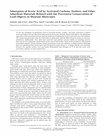 |
António João Cruz, João Pires, Ana P. Carvalho, M. Brotas de Carvalho, "Adsorption of acetic acid by activated carbons, zeolites, and other adsorbent materials related with the preventive conservation of lead objects in museum showcases", Journal of Chemical and Engineering Data, 49(3), 2004, pp. 725-731, doi:10.1021/je034273w |
| Abstract |
To test the suitability of adsorbents such as activated carbons, zeolites, and other materials to adsorb acetic acid vapors that are liberated inside museum showcases and may destroy lead objects, the adsorption capacities at the saturation pressure and the isotherms of adsorption at lower pressures were determined. The results obtained show that the NaX zeolite in pellet form and the RB4 activated carbon are the best adsorbents. Additionally, they show that materials with sodium content exhibit an exchange process that may be very important, particularly in the case of NaX zeolite. Some of the parameters determined (saturation capacity, Henry constant, kinetic parameter) seem to be related in a simple manner (although there are adsorbents that do not agree with the general trend). However, a simple relation was not found between the specific surface area previously determined with nitrogen at 77 K and the acetic acid saturation capacity at room temperature. |
